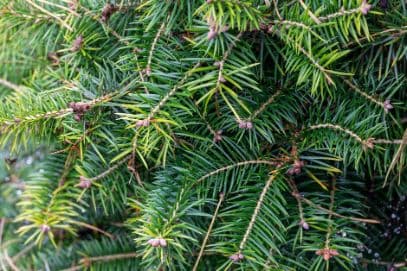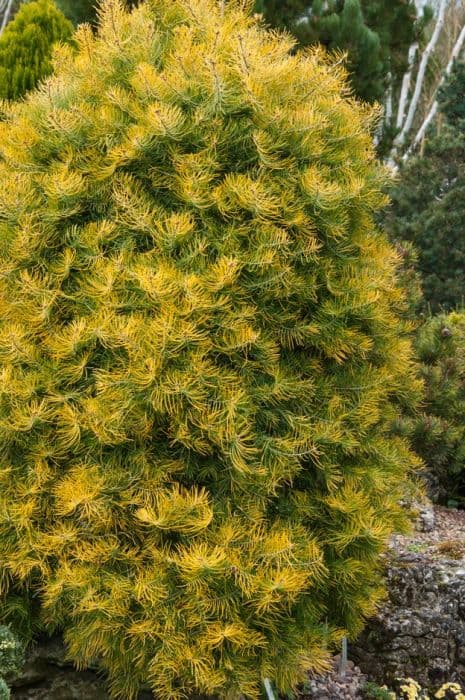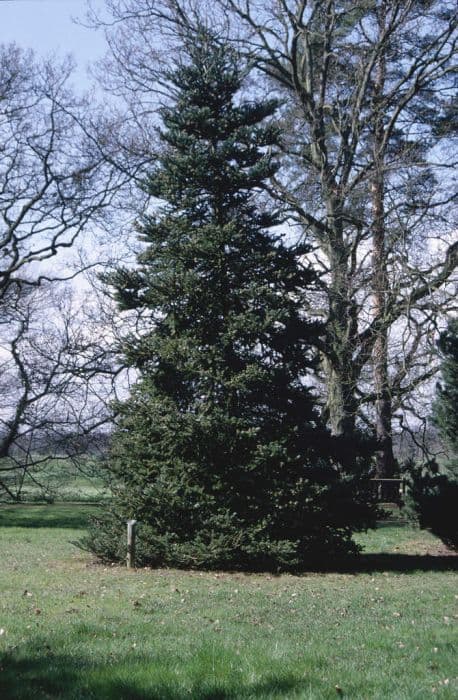Blue Atlas Cedar Cedrus atlantica Glauca Group

ABOUT
The Blue Atlas Cedar, which bears the name Cedrus atlantica Glauca Group, is a striking and majestic conifer known for its distinctive, icy blue to silvery blue-green foliage. Its needles are arranged in clusters, giving the branches a full, tufted appearance that can catch the light and create a shimmering effect. The needles themselves are short and stiff, which contributes to the dense and somewhat spiky texture of the foliage. As the Blue Atlas Cedar matures, its overall form becomes broadly pyramidal to almost columnar in shape, presenting a dignified and imposing silhouette. The branches tend to be horizontal or slightly weeping, giving the tree a graceful, yet robust character. When observed closely, the branches show a rhythmic arrangement, with the tips often curving upwards. The bark of the Blue Atlas Cedar is another distinctive feature, quite rough to the touch, with deep fissures and an attractive grey to silvery-grey hue that serves to accentuate the blue tones of the needles. During the fall or winter seasons, one can witness the production of ornamental cones which take on a barrel shape. Initially, these cones, generally appearing on more mature specimens, have a greenish tone but mature to a more woody brown as they age and dry. They add an extra layer of interest and texture to the tree's overall appearance. In landscape use, the Blue Atlas Cedar is often prized for its striking color and form, serving as a focal point or specimen plant. Its unique appearance makes it a natural choice for gardens aiming to create an impactful visual statement.
About this plant
 Names
NamesFamily
Pinaceae.
Synonyms
Blue Atlas Cedar, Silver Atlas Cedar, Blue Cedar.
Common names
Cedrus libani subsp. atlantica, Cedrus atlantica.
 Toxicity
ToxicityTo humans
The Blue Atlas Cedar (Cedrus atlantica Glauca Group) is generally considered non-toxic to humans. However, like many plants, consuming parts of the Blue Atlas Cedar could potentially cause gastrointestinal discomfort or irritation. There are no well-documented cases of poisoning from this plant in humans, and it is unlikely to cause harm beyond the possible mild reactions mentioned. If large amounts were ingested, or if an individual had a specific allergy to the plant, more serious symptoms could potentially occur, but this is not common.
To pets
The Blue Atlas Cedar (Cedrus atlantica Glauca Group) is also considered non-toxic to pets. There is no significant evidence that suggests this plant poses a serious risk to animals if ingested. Nonetheless, as with any non-food item, if a pet consumes parts of the Blue Atlas Cedar, they might experience mild gastrointestinal upset, such as vomiting or diarrhea. In general, it is always best to prevent pets from eating ornamental plants as a precaution.
 Characteristics
CharacteristicsLife cycle
Perennials
Foliage type
Evergreen
Color of leaves
Blue-green
Height
40-60 feet (12-18 meters)
Spread
10-15 feet (3-4.5 meters)
Plant type
Tree
Hardiness zones
6
Native area
Atlas Mountains
Benefits
 General Benefits
General Benefits- Aesthetic Appeal: The Blue Atlas Cedar provides a striking blue-green foliage that adds color and visual interest to landscapes.
- Shade Provision: Mature trees create ample shade, making outdoor spaces more comfortable during hot weather.
- Habitat for Wildlife: Birds and other wildlife often use the tree for nesting and shelter.
- Windbreak: Its dense branching can serve as a protective barrier against winds.
- Soil Stability: The tree's root system can help prevent soil erosion.
- Longevity: Blue Atlas Cedar is known for its long life span, providing lasting benefits to the environment.
- Seasonal Interest: This evergreen maintains its color throughout the year, with new growth adding interest in the spring.
- Drought Resistance: Once established, it is relatively drought tolerant, requiring less water compared to some other species.
- Low Maintenance: Blue Atlas Cedar generally requires minimal care once established, making it a convenient choice for gardeners.
 Medical Properties
Medical Properties- This plant is not used for medical purposes
 Air-purifying Qualities
Air-purifying QualitiesThis plant is not specifically known for air purifying qualities.
 Other Uses
Other Uses- The Blue Atlas Cedar's wood can be used for crafting fine furniture due to its durability and pleasant scent.
- Intricately carved wood from the Blue Atlas Cedar is often used in decorative panels and architectural detailing.
- Essential oils derived from the Blue Atlas Cedar are used in perfumery for their distinct, woody fragrance.
- The tree's thick, columnar structure makes it a natural choice for creating privacy screens and hedges in landscaping.
- Due to its resistance to rot, the wood of Blue Atlas Cedar is valuable for outdoor construction, including decking and fencing.
- The sawdust and shavings from Blue Atlas Cedar can be used in the stuffing of traditional straw mattresses and pillows in some cultures.
- Spiritual practitioners use the aromatic wood of the Blue Atlas Cedar to create incense and in ceremonial purifying rituals.
- Woodworkers value the tree's unique blue-tinged wood for making specialty items like musical instruments and artistic sculptures.
- Blue Atlas Cedar cones can be used in craft projects and festive decorations, especially during the holiday season.
- In historical shipbuilding, the durable wood of the Blue Atlas Cedar was sometimes used for masts and planking.
Interesting Facts
 Feng Shui
Feng ShuiThe Blue Atlas Cedar is not used in Feng Shui practice.
 Zodiac Sign Compitability
Zodiac Sign CompitabilityThe Blue Atlas Cedar is not used in astrology practice.
 Plant Symbolism
Plant Symbolism- Strength and Endurance: Cedrus atlantica, commonly known as the Atlas cedar, symbolizes strength and endurance due to its robust nature and ability to grow in harsh mountainous environments.
- Longevity: The Atlas cedar can live for centuries, making it a symbol of longevity and timelessness.
- Resilience: Capable of withstanding extreme conditions, the Atlas cedar represents resilience in the face of adversity.
- Purity: With its evergreen foliage and aromatic wood, the Atlas cedar is often associated with purity and cleansing properties.
- Protection: In many cultures, cedar trees are believed to offer protection and are planted as guardians of homes and sacred places.
 Water
WaterThe Blue Atlas Cedar prefers occasional deep watering rather than frequent shallow waterings, especially during dry conditions. Typically, watering this plant thoroughly once every two to four weeks is adequate, but this may vary based on climate and soil conditions. In terms of water volume, young trees benefit from 10 to 15 gallons per watering, ensuring that the water penetrates deeply into the soil to encourage deep root growth. Established Blue Atlas Cedars are drought-tolerant and may require less frequent watering, depending on rainfall and soil moisture.
 Light
LightThe Blue Atlas Cedar thrives best in full sun conditions, where it can receive at least six hours of direct sunlight daily. It should be planted in a spot that is free from buildings or other plants that could cast significant shade on it. These cedars do not perform well in shaded areas, as insufficient light can affect their growth and needle health.
 Temperature
TemperatureBlue Atlas Cedars are hardy and can tolerate a wide range of temperatures; they can withstand winter lows down to -20 degrees Fahrenheit and summer highs well above 100 degrees Fahrenheit. However, the ideal temperature range for this plant is between 60 and 75 degrees Fahrenheit. They can endure occasional temperature fluctuations outside this range without serious damage.
 Pruning
PruningPruning of Blue Atlas Cedars should be done for shaping and removing dead or damaged branches; it's not typically necessary for the health of the tree. The best time to prune is in late winter to early spring before new growth begins. Light pruning to shape the tree can be done annually, while more thorough pruning should be less frequent, only as needed to maintain the desired form.
 Cleaning
CleaningNot needed
 Soil
SoilBlue Atlas Cedar thrives in well-draining, loamy or sandy soil with a slightly acidic to neutral pH of 6.0 to 7.5. A mixture containing one-third each of topsoil, peat moss, and coarse sand or perlite is ideal, ensuring proper drainage and aeration.
 Repotting
RepottingAs a slow-growing tree, Blue Atlas Cedar does not need frequent repotting; once every 3 to 5 years is sufficient. It is best repotted in spring before new growth begins, allowing the roots to establish in the new pot.
 Humidity & Misting
Humidity & MistingBlue Atlas Cedar prefers a dry to moderate humidity level, typical of its native habitat in mountainous regions. It is well-suited to outdoor conditions and does not require high humidity to thrive.
 Suitable locations
Suitable locationsIndoor
Ensure bright light, cool temp, and air circulation for indoor Blue Atlas Cedar.
Outdoor
Plant in sunny spot, well-draining soil; tolerate cold, dry conditions.
Hardiness zone
6-9 USDA
 Life cycle
Life cycleThe Blue Atlas Cedar (Cedrus atlantica Glauca Group) begins its life as a seed, often within a cone that requires a period of over a year to mature. Upon germination, it first develops a taproot and then a small rosette of needle-like leaves, entering its seedling stage, which can last for several years. As it grows into a sapling, its distinctive silver-blue needles become more pronounced and it begins to develop a conical shape. During its lengthy juvenile phase, the Blue Atlas Cedar will steadily grow taller and wider, which can continue for 20 to 40 years before reaching maturity. In its mature stage, it can exhibit increased cone production and reaches its full height, often between 40 to 60 feet or more, with a broad, pyramidal form. Once fully grown, assuming ideal conditions, the Blue Atlas Cedar can live and remain productive for over 300 years, with some individuals becoming monumental in size.
 Propogation
PropogationPropogation time
Spring to Summer
Propogation: The most popular method of propagation for the Cedrus atlantica Glauca Group, commonly known as the Blue Atlas Cedar, is through seeds. The best time to collect seeds for planting is in the fall after the cones have matured and begun to open. Once collected, the seeds must first be extracted from the cones and then undergo a process of cold stratification to simulate winter conditions; this typically involves storing the seeds in a cold place, between 32 and 41 degrees Fahrenheit (0 to 5 degrees Celsius), for a period of one to three months to break dormancy. After stratification, the seeds are sown in well-draining soil mix and placed in a location with indirect sunlight. Seedlings require consistent moisture and should not be allowed to dry out, but also need to avoid waterlogging to prevent rot. The germination rate can be slow and sporadic, and it may take several years before the young trees are ready for transplanting into the landscape.









